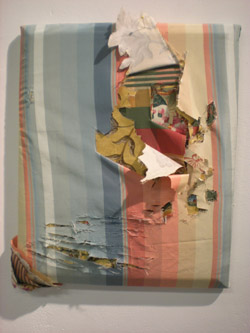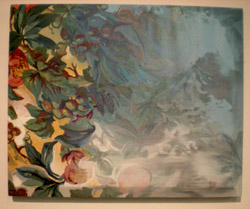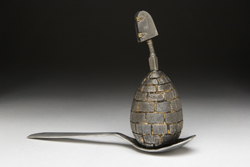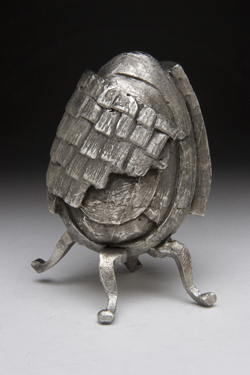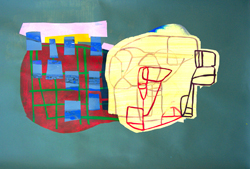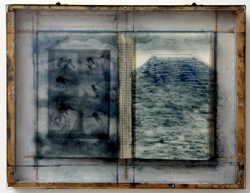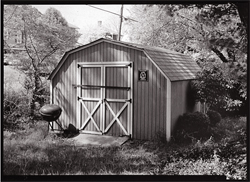Satellite Exhibition
A Muse Among Us
MINDS WIDE OPEN: Virginia Celebrates Women in the Arts 2010
January 8 — April 25, 2010
Arts Advocacy Day: January 28
A Muse Among Us/ MINDS WIDE OPEN: Virginia Celebrates Women in the Arts 2010 is a collection of artists whose work can be described as feminine and representative of their many obsessions, curiosities and desires. Playful, ironic, detached or compassionate... her muse is among us, regardless of the age.
The Linden Row Inn is a historic space. The mission of our curatorial work for this venue is the goal of exhibiting contemporary art that will complement and provide a contrast with period interiors and architecture versus a white box which can be altered.
For more information or to purchase a work of art please call the 1708 Gallery staff at 804.643.1708 or curator, Amie Oliver at 804.615.0754.
Exhibiting Artists
Mixed media by Hetty Baiz
Our body is a physical manifestation of impermanence and the transient quality of all of life. It is in a constant state of flux and transformation. Whether the coming and going of the breath, the ebb and flow of ideas, the birth and death of living beings, this moment by moment unfolding is a mysterious and integral part of our existence.
Inspired by these ideas, I have created a body of work in which I use the figure as a vehicle for expression. I work intuitively and directly without plans or preconceived notions of what the final outcome will be. Experimenting with a wide range of materials -- from paint, tissue paper and canvas, to plaster, floor tiles, wood and fire -- I put down materials and peel layers away until the piece is resolved. I equate the way I work to jazz, improvising and responding as the work unfolds. For me, creating is a process of discovery.
Photography by Regi Franz
The Dreamtime is the Aboriginal understanding of the world, its creation and great stories – it is the beginning of knowledge, from which came the laws of existence.
I am interested in the impact specific places and surroundings have on our psyche, and how memory, dream and illusion are guiding where I choose to photograph. In some sense, the quest for self discovery becomes a journey in every sense of the word.
Having left my native land as a young adult a long time ago, the search for home is a central topic in my work at this moment. I feel that I can physically hold on to the places I photograph, literally gather them as keepsakes, even declare them as ‘home’.
I find solace to leave the fast-paced, anonymous life of the urban environment behind – it neither offers the time nor space for a comforting place where I can belong.
Dreamtime also refers to Buddhist philosophy which does not distinguish between reality and dream states – all is one, in the here and now. I am manifesting this concept in my photographs, and welcome the specific freedom it holds.
Fiber work by Colleen Judge
Paintings on paper and canvas by Megan Marlatt
For the last seven years, my work has drawn inspiration from the multitude of quirky characters and funky forms produced in plastic toys. Most of the toys I have chosen to paint are products of children’s packaged fast food meals thrown away and found in thrift stores and yard sales. The paintings I have created from these discarded playthings often fall into two opposite categories: one being critical of our consumer society, the other being complicit to it. Colorful and glossy, I sometimes painted these small toys in densely packed piles that spoke to me of mass consumerism, chaos and cultural vertigo. Like Maya Lin’s recent sculptures of “asteroids” and installations created from the same kinds of plastic toys, we both see these as “everyday objects whose use-value is ritualistic, emotional, consumerist.” Yet at other times, I have handled them as if they were forgotten treasure. I have set apart special toys and with the eye of a child, focused on them as endearingly as he or she would a favorite plaything, animating them through paint.
Metals by Cindy Myron
Ordinary, mundane, and common spaces act as expressive vehicles for the human body and mind. Because of this, I create a dialogue between humans and their intimate architectural spaces, usually the home. “Home” often times acts a symbol of safety and shelter. I use this idea of home and translate it into packaged form, stripped down bare and forced into a portable and playful form, much like a collage, curiosity cabinet or relic.
Within these pieces whether sculptural, functional or wearable, seemingly ordinary spatial elements such as moldings, cedar shakes or windows become materialistically empty yet narrative when view together as specimens. As homes and people grow and change in form, the idea of “home” easily becomes a part of everyday consumerism much like society’s convenience or material compulsions.
Homes are recycled and devoured as spaces for safety, comfort and even self worth.
Paintings by Jody L. Symula
Gnarled broken umbrellas, discarded on the side of the street. A shiny barn rooftop in the middle of a freshly plowed brown field, long cast shadows on the side of a tall window-filled building, colorful jaunty window displays in stores. I’m surrounded by visual cues that unexpectedly spark, stay with me, and somehow translate into painting. Along with these visual cues I embrace experimentation as each painting is a ride of its own full of stops, starts, layers, and directions before finally arriving at a finished destination.
Bookworks and collage by Grace K. A. Teeples
After working in a diptych form for years, it seemed a natural lateral move to the book. Considered formally (sans words), a book with its central spine also elicits comparisons between two sides. Book or bone construction and repair are explored more obviously in some and less so in other works. The issues of compression, joinery, contrast between hard and soft, and shifting layers of meaning are fundamental to each piece.
Relationships between process and media engender content. Some of the media used include: handmade paper, cast paper, book spines, plexiglass, wood, and cataloging cards. Book pages and unwanted student work comprise much of the handmade paper.
The visual effect of repair is a fundamental concern. The physical results of restoration relate to my encounters with orthopedic repairs. “Preservation” exposes the crash used to support the spines. Other works explore the effect of metal or wood piercing paper (like metal would flesh). The confined vocabulary of imagery evokes a reflective response from the viewer, like a whisper in a crowded room.
Photography by Jennifer Watson
These works are from a series titled “The Vernacular Backyard: Sheds of an American Community” and were funded by a grant from the Graham Foundation for the Advanced Studies of the Fine Arts. Each shed was photographed with a 5x7 view camera and printed using an antiquated contact process called Printing-Out Paper. Instead of printing in the darkroom, the photographer uses the sun as the enlarger. This process was popular during the 1920s, when many of the sheds were being built. Each print is fixed in a bath of gold chloride and has a 350 year archival life.
Excerpt from “The Vernacular Backyard: Sheds of an American Community”
A real estate agent I know advises that any house going on the market have a brass kick plate put on the front door. You will see no brass kick plates in the following photographs. Sheds are spared the humiliations of pretension. They escape the tyranny of fashion. They make do. They are proportionate to need. Although not void of ornament or design, they report to no aesthetic committee. They have slipped through the cracks.
They are allowed to tell the truth about time and gravity, wind and sun. The outside comes in, and sometimes the inside falls out. They are left alone, away from the nervous attention of human desire.
I want to be a shed

![Steintreppe [Stone Steps], Regi Franz](../../img/exhibitions/satellite/01082010_a_muse_among_us/02_Franz_Steintreppe_StoneSteps.jpg)
